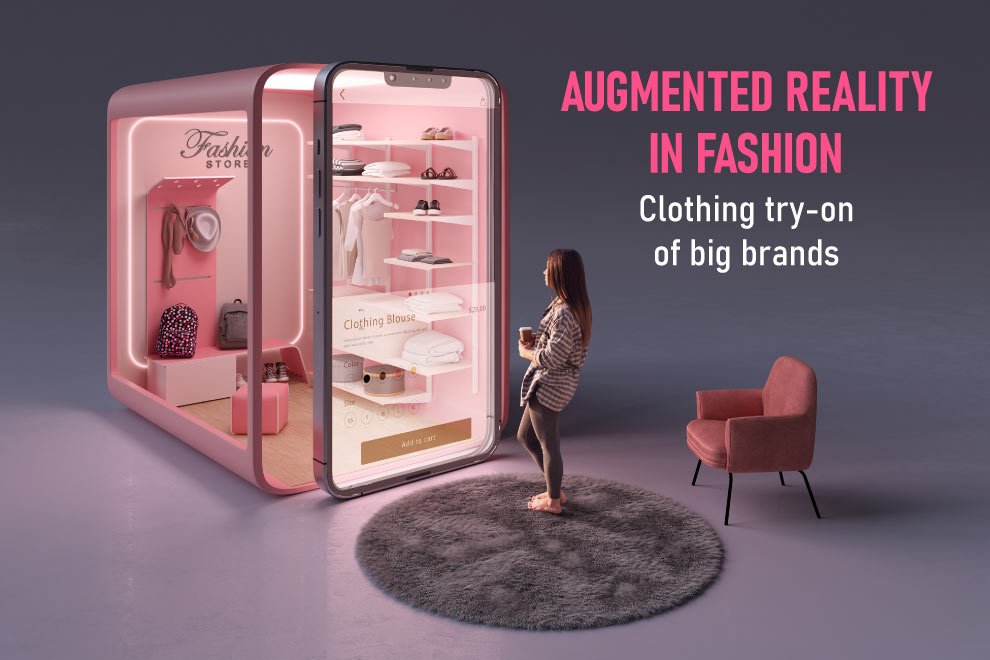The world of fashion and retail is being revolutionized by emerging augmented and virtual reality technologies. Leading fashion brands are integrating immersive try-on experiences and 3D visualizations to redefine the shopping journey for 21st-century consumers. With the ability to digitally ‘try on’ clothing from the comfort of home, Augmented Reality in fashion is ready to spread its wings and make disruptive changes.
A New Age of Experiential Shopping
Augmented reality, in the most simple terms, is a domain of immersive reality development that aims at creative digital images that can be imposed and viewed on the objects that exist in the physical world. This merger of real and digital is fuelling a new age of experiential, immersive shopping.
Now, AR applications are allowing consumers to virtually try on apparel and accessories from global brands. By simply launching a mobile app or website, shoppers can see photorealistic 3D renderings of products imposed onto their live video feed. As AR overlays digital clothing onto real bodies in actual spaces, the experience is very similar to what many define as a “virtual changing room” that allows the brands to create virtual try-on options for their customers but without all the hassle and complications.
Virtual Dressing Rooms and Try-on
While early AR try-on concepts projected basic shapes onto users, today’s virtual dressing rooms feature true-to-life modeling. Advanced algorithms, computer vision, 3D mapping, and rendering techniques are helping in creating an ultra-realistic visualization of fabrics, patterns, and fit.
Leading fashion brands like Gucci, Farfetch, and Dior are developing immersive mobile apps and web portals to adapt their apparel catalog to the upcoming changes. Using smartphone cameras, shoppers can browse hundreds of clothing items and accessorize their AR avatars. They might try a Ralph Lauren winter coat atop their outfit, or display Valentino sunglasses on their face with precise sizing and positioning. This fusion of physical reality and interactive digital content empowers shoppers to become their virtual stylists before buying and makes the entire process more entertaining and efficient.
Popular Brands Acting as Flag Bearers
These are some of the brands that have not only enacted AR in their services but are also the first ones to popularize its use.
Gucci
The first on the list is one of the most popular and well-known fashion brands. Gucci has created an augmented reality app allowing users to virtually try on sneakers. The ultra-high fidelity visualization lets you view true-to-life scale models of the shoes mapped onto your feet from every angle.
Farfetch
Farfetch is a fashion and e-commerce studio that uses augmented reality to enable the trial of products including glasses and watches. Their immersive portal displays photorealistic holograms on your hands and wrists via your device’s camera. Their hologram is super realistic and helps the customers in getting an idea over what they will be buying without wasting much of their time in physical stores.
Sephora
Sephora has been using AR for as long as 2013, trying to blend in the experience of physical stores with the convenience that can be enjoyed through online shopping. They have developed multiple features from AR to help in choosing perfumes to make-up based on your face. Making the shopping experience irritation-free and fun for its customers.
Ralph Lauren
Polo Ralph Lauren has unveiled an AR shopping tool to digitize their clothing catalog. Their AR features allow the shoppers to test out winter jackets and tracksuits matched to their figures by overlaying extremely realistic 3D models onto camera feeds.
Valentino
Valentino is now offering a virtual try-on for their sunglasses collection. By using facial mapping, their augmented reality simulator applies the precise sizing and positioning of the frames directly onto your face for inspection.
The Future of Augmented Reality in Fashion
Virtual Try-ons will act as a paradigm shift in the world of fashion and business. Not only will the new developments be more efficient, but also more interactive and customer-based.
Streamlined purchasing will be improved by using dynamic customer data profiles. AR apps can suggest sizes, styles, and new releases best suited to individual body shapes, complexions, and preferences via smart algorithms. For retailers, these immersive simulators promise improved conversion rates, sales growth, and customer loyalty through personalization. Expensive stock may be shelved less in physical stores as virtual inventories grow. In the future, holographic models and digital showrooms could even replace traditional runway events and fashion shows.
Conclusion
The trends in fashion and retail are ever-changing. Today, Augmented Reality in fashion is the need for development to ensure that customers remain curious and enjoy the shopping experience. AR-based virtual Try-ons will be extremely big for the next few years. If you own a fashion brand, employing a bit of AR touch to those products could add a lot of excitement. Check out no-code platforms like PlugXR that lets you build AR experience on your own without technical fuss!!
Also Read: The Ultimate Guide to Vegan Leather: Types, Benefits, and Tips










